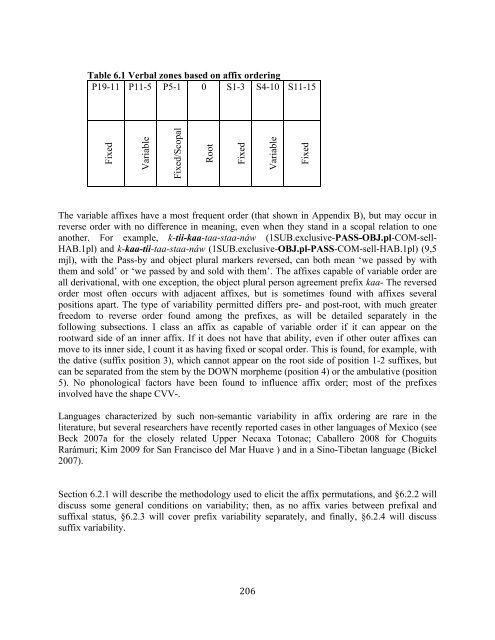The phonology and morphology of Filomeno Mata Totonac
The phonology and morphology of Filomeno Mata Totonac
The phonology and morphology of Filomeno Mata Totonac
Create successful ePaper yourself
Turn your PDF publications into a flip-book with our unique Google optimized e-Paper software.
Table 6.1 Verbal zones based on affix ordering<br />
P19-11 P11-5 P5-1 0 S1-3 S4-10 S11-15<br />
Fixed<br />
Variable<br />
Fixed/Scopal<br />
Root<br />
Fixed<br />
<strong>The</strong> variable affixes have a most frequent order (that shown in Appendix B), but may occur in<br />
reverse order with no difference in meaning, even when they st<strong>and</strong> in a scopal relation to one<br />
another. For example, k-tii-kaa-taa-staa-náw (1SUB.exclusive-PASS-OBJ.pl-COM-sell-<br />
HAB.1pl) <strong>and</strong> k-kaa-tii-taa-staa-náw (1SUB.exclusive-OBJ.pl-PASS-COM-sell-HAB.1pl) (9,5<br />
mjl), with the Pass-by <strong>and</strong> object plural markers reversed, can both mean ‘we passed by with<br />
them <strong>and</strong> sold’ or ‘we passed by <strong>and</strong> sold with them’. <strong>The</strong> affixes capable <strong>of</strong> variable order are<br />
all derivational, with one exception, the object plural person agreement prefix kaa- <strong>The</strong> reversed<br />
order most <strong>of</strong>ten occurs with adjacent affixes, but is sometimes found with affixes several<br />
positions apart. <strong>The</strong> type <strong>of</strong> variability permitted differs pre- <strong>and</strong> post-root, with much greater<br />
freedom to reverse order found among the prefixes, as will be detailed separately in the<br />
following subsections. I class an affix as capable <strong>of</strong> variable order if it can appear on the<br />
rootward side <strong>of</strong> an inner affix. If it does not have that ability, even if other outer affixes can<br />
move to its inner side, I count it as having fixed or scopal order. This is found, for example, with<br />
the dative (suffix position 3), which cannot appear on the root side <strong>of</strong> position 1-2 suffixes, but<br />
can be separated from the stem by the DOWN morpheme (position 4) or the ambulative (position<br />
5). No phonological factors have been found to influence affix order; most <strong>of</strong> the prefixes<br />
involved have the shape CVV-.<br />
Languages characterized by such non-semantic variability in affix ordering are rare in the<br />
literature, but several researchers have recently reported cases in other languages <strong>of</strong> Mexico (see<br />
Beck 2007a for the closely related Upper Necaxa <strong>Totonac</strong>; Caballero 2008 for Choguits<br />
Rarámuri; Kim 2009 for San Francisco del Mar Huave ) <strong>and</strong> in a Sino-Tibetan language (Bickel<br />
2007).<br />
Section 6.2.1 will describe the methodology used to elicit the affix permutations, <strong>and</strong> §6.2.2 will<br />
discuss some general conditions on variability; then, as no affix varies between prefixal <strong>and</strong><br />
suffixal status, §6.2.3 will cover prefix variability separately, <strong>and</strong> finally, §6.2.4 will discuss<br />
suffix variability.<br />
! #.*!<br />
Variable<br />
Fixed

















